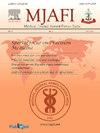拟除虫菊酯中毒:对人体有轻微毒性的杀虫剂
Q2 Medicine
引用次数: 0
摘要
拟除虫菊酯类杀虫剂是常用的杀虫剂。本研究旨在描述使用1型和2型拟除虫菊酯的故意自残(DSH)的临床特征和结果,并确定与住院需要相关的因素。方法回顾性研究印度南部某三级医院DSH致拟除虫菊酯中毒患者的临床特点、治疗及转归。患者被分为1型或2型拟除虫菊酯化合物中毒。使用双变量和多变量回归分析探讨与住院需求相关的因素,并以95%置信区间(ci)的优势比(OR)表示。结果379例患者出现拟除虫菊酯中毒;男性202例(53.3%)。年龄中位数(四分位数间距)为26岁(22-33岁)。氟氯菊酯(n = 48, 58%)和氯氰菊酯(n = 149, 50%)分别是最常涉及的1类化合物和2类化合物。在入院的130例(34.3%)患者中,13例(3.4%)患者需要机械通气。所有患者都存活了下来。在多因素logistic回归分析中,摄入2型拟除虫菊酯(OR: 2.55, 95%CI: 1.31-4.97)、癫痫发作史(OR: 2.62, 95%CI: 1.06-6.48)和转诊医院前的治疗(OR: 2.99, 95%CI: 1.87-4.74)与住院需求相关。结论拟除虫菊酯中毒患者需住院治疗的占1 / 3。2型拟除虫菊酯中毒在临床上更为常见。摄入2型拟除虫菊酯、癫痫发作和需要院前治疗与住院有关。本文章由计算机程序翻译,如有差异,请以英文原文为准。
Pyrethroid poisoning: Insecticide with mild human toxicity
Background
Pyrethroid insecticides are commonly used insecticides. This study was undertaken to characterize the clinical profile and outcome of deliberate self-harm (DSH) with type 1 and type 2 pyrethroids and identify factors associated with need for hospitalization.
Methods
This retrospective study was conducted in a tertiary care hospital in South India to study the clinical features, treatment, and outcome of patients with pyrethroid poisoning due to DSH. Patients were categorized as poisoning with type 1 or type 2 pyrethroid compounds. Factors associated with need for hospital admission was explored using bivariate and multivariate regression analysis and expressed as odds ratio (OR) with 95% confidence intervals (CIs).
Results
A total of 379 patients presented with pyrethroid poisoning; 202 (53.3%) patients were male. The median (interquartile range) age was 26 (22–33) years. Transfluthrin (n = 48, 58%) and cypermethrin (n = 149, 50%) were the most frequently implicated type 1 compounds and type 2 compounds, respectively. Of the 130 (34.3%) patients who were admitted, 13 (3.4%) patients required mechanical ventilation. All patients survived. On multivariate logistic regression analysis, ingestion of type 2 pyrethroids (OR: 2.55, 95%CI: 1.31–4.97), history of seizures (OR: 2.62, 95%CI 1.06-6.48), and treatment prior to presentation to the referral hospital (OR: 2.99, 95%CI: 1.87–4.74) were associated with the need for hospitalization.
Conclusion
A third of patients with pyrethroid poisoning require hospitalization. Type 2 pyrethroid poisoning is more frequent in clinical practice. Ingestion of type 2 pyrethroids, seizures, and need for pre-hospital treatment are associated with hospitalization.
求助全文
通过发布文献求助,成功后即可免费获取论文全文。
去求助
来源期刊

Medical Journal Armed Forces India
Medicine-Medicine (all)
CiteScore
3.40
自引率
0.00%
发文量
206
期刊介绍:
This journal was conceived in 1945 as the Journal of Indian Army Medical Corps. Col DR Thapar was the first Editor who published it on behalf of Lt. Gen Gordon Wilson, the then Director of Medical Services in India. Over the years the journal has achieved various milestones. Presently it is published in Vancouver style, printed on offset, and has a distribution exceeding 5000 per issue. It is published in January, April, July and October each year.
 求助内容:
求助内容: 应助结果提醒方式:
应助结果提醒方式:


